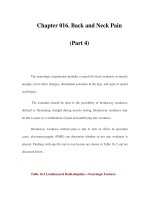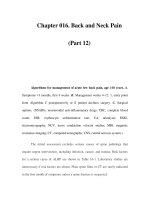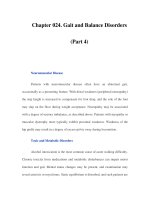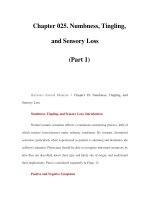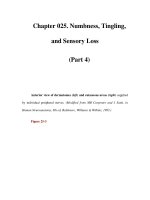Chapter 025. Numbness, Tingling, and Sensory Loss (Part 4) pdf
Bạn đang xem bản rút gọn của tài liệu. Xem và tải ngay bản đầy đủ của tài liệu tại đây (62.88 KB, 5 trang )
Chapter 025. Numbness, Tingling,
and Sensory Loss
(Part 4)
Anterior view of dermatomes (left) and cutaneous areas (right) supplied
by individual peripheral nerves. (Modified from MB Carpenter and J Sutin, in
Human Neuroanatomy, 8th ed, Baltimore, Williams & Wilkins, 1983.)
Figure 25-3
Posterior view of dermatomes (left) and cutaneous areas (right)
supplied by individual peripheral nerves. (Modified from MB Carpenter and J
Sutin, in Human Neuroanatomy, 8th ed, Baltimore, Williams & Wilkins,
1983.)Temperature sensation, to both hot and cold, is best tested with small
containers filled with water of the desired temperature. This is impractical in most
settings. An alternative way to test cold sensation is to touch a metal object, such
as a tuning fork at room temperature, to the skin. For testing warm temperatures,
the tuning fork or other metal object may be held under warm water of the desired
temperature and then used. The appreciation of both cold and warmth should be
tested because different receptors respond to each.
Touch is usually tested with a wisp of cotton or a fine camelhair brush. In
general, it is better to avoid testing touch on hairy skin because of the profusion of
sensory endings that surround each hair follicle.
Joint position testing is a measure of proprioception, one of the most
important functions of the sensory system. With the patient's eyes closed, joint
position is tested in the distal interphalangeal joint of the great toe and fingers. If
errors are made in recognizing the direction of passive movements, more proximal
joints are tested. A test of proximal joint position sense, primarily at the shoulder,
is performed by asking the patient to bring the two index fingers together with
arms extended and eyes closed. Normal individuals can do this accurately, with
errors of 1 cm or less.
The sense of vibration is tested with a tuning fork that vibrates at 128 Hz.
Vibration is usually tested over bony points, beginning distally; in the feet, it is
tested over the dorsal surface of the distal phalanx of the big toes and at the
malleoli of the ankles, and in the hands dorsally at the distal phalanx of the
fingers. If abnormalities are found, more proximal sites can be examined.
Vibratory thresholds at the same site in the patient and the examiner may be
compared for control purposes.
Quantitative Sensory Testing
Effective sensory testing devices are now available commercially.
Quantitative sensory testing is particularly useful for serial evaluation of cutaneous
sensation in clinical trials. Threshold testing for touch and vibratory and thermal
sensation is the most widely used application.
Cortical Sensation
The most commonly used tests of cortical function are two-point
discrimination, touch localization, and bilateral simultaneous stimulation and tests
for graphesthesia and stereognosis. Abnormalities of these sensory tests, in the
presence of normal primary sensation in an alert cooperative patient, signify a
lesion of the parietal cortex or thalamocortical projections to the parietal lobe. If
primary sensation is altered, these cortical discriminative functions will usually be
abnormal also. Comparisons should always be made between analogous sites on
the two sides of the body because the deficit with a specific parietal lesion is likely
to be unilateral. Interside comparisons are important for all cortical sensory
testing.
Two-point discrimination is tested by special calipers, the points of which
may be set from 2 mm to several centimeters apart and then applied
simultaneously to the site to be tested. The pulp of the fingertips is a common site
to test; a normal individual can distinguish about 3-mm separation of points there.


